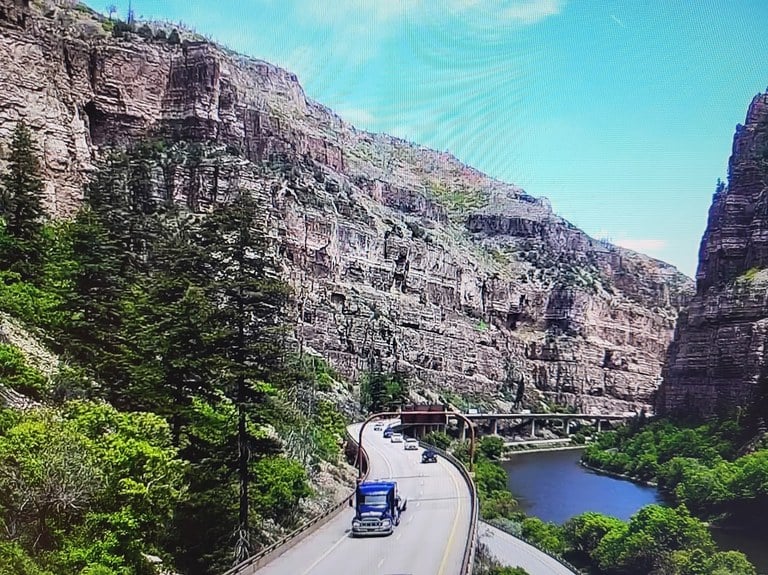I-70 Glenwood Canyon safety protocols updated for upcoming season
Travel Advisory
Statewide — The Colorado Department of Transportation, in partnership with the U.S. Forest Service (USFS), National Oceanic and Atmospheric Administration (NOAA), the U.S. Geological Survey (USGS) and others, has updated safety protocols for Interstate 70 through Glenwood Canyon ahead of the 2025 summer travel season. These adjustments come after the 2020 Grizzly Creek Fire and subsequent years’ mudslides prompted additional safety measures to protect both motorists and crews traveling on I-70 through Glenwood Canyon.
In collaboration with Glenwood Canyon stakeholder agencies, it has been determined that there is a reduced threat level compared to previous years, based on indicators such as burn scar recovery and debris flow potential. Officials are projecting normal conditions in Glenwood Canyon for the upcoming summer. As a result, CDOT and its partners will adjust inclement weather protocols.

While stakeholder agencies, such as USGS, NOAA and USFS, will continue to monitor and alert CDOT concerning weather forecasts and conditions, the following updated safety protocols will be implemented throughout Glenwood Canyon starting in June 2025. These adjustments aim to ensure continued safety and preparedness as travel volume increases in peak summer travel periods.
Glenwood Canyon Safety Protocols
Flash Flood Watch I-70 protocol
Previously, under the I-70 Protocol, maintenance crews were stationed at the two primary closure points along I-70 at mile point 133 (Dotsero) and MP 116 (Glenwood Springs) when a Flash Flood Watch was issued. Moving forward, CDOT crews will implement standard traffic control measures at all closure points and will actively monitor conditions in Glenwood Canyon using cameras and personnel on the ground.
Flash Flood Warning I-70 protocol
Under the previous protocol, I-70 through Glenwood Canyon would close when a Flash Flood Warning was issued, with maintenance crews coordinating with the Colorado State Patrol. This summer, however, crews will continuously monitor conditions and keep I-70 open—along with rest areas and the recreation path—as long as it remains safe. This also includes maintaining access for both private and commercial rafting groups.
I-70 Safety Messages
Motorists planning to travel on I-70, visit rest areas or use the recreation path in Glenwood Canyon should pay attention to road conditions on COtrip.org and the COtrip Planner App, as well as nearby overhead I-70 digital message boards and weather forecasts. In the instance an extended closure is expected, CDOT will send information to stakeholders.
Prepare for Traveling on I-70 in Glenwood Canyon
- Frequently Asked Questions (FAQ)
- Plan ahead, know before you go and check for the latest road conditions by going to COtrip.org or the COtrip Planner App
- Know the latest weather conditions
- Give yourself extra time and avoid traveling during adverse weather conditions
- Have an emergency kit in your vehicle, including extra food, water, medicine, clothing, batteries, and other necessities
- Make sure your car is in safe driving condition with adequate tires
- When on the road, obey the speed limit and don’t follow too closely; speeding and tailgating are among the leading causes of crashes, injuries, and fatalities
Know Before You Go
Travelers are urged to “know before you go.” Gather information about weather forecasts and anticipated travel impacts and current road conditions prior to hitting the road. CDOT resources include:
- Road conditions and travel information: COtrip.org
- Download the COtrip Planner app: bit.ly/COtripapp
- Sign up for project or travel alerts: bit.ly/COnewsalerts
- Check scheduled construction lane closures: bit.ly/laneclosures
- Connect with @ColoradoDOT on social media: X, Facebook, Instagram and YouTube
Remember: Slow For The Cone Zone
The following tips are to help you stay safe while traveling through maintenance and construction work zones.
- Do not speed in work zones. Obey the posted speed limits.
- Stay Alert! Expect the unexpected.
- Watch for workers. Drive with caution.
- Don't change lanes unnecessarily.
- Avoid using mobile devices such as phones while driving in work zones.
- Turn on headlights so that workers and other drivers can see you.
- Be especially alert at night while driving in work zones.
- Expect delays, especially during peak travel times.
- Allow ample space between you and the car in front of you.
- Anticipate lane shifts and merge when directed to do so.
- Be patient!
Download the COtrip App!
The new free COtrip Planner mobile app was designed to meet the growing trend of information on mobile and tablet devices for the traveling public. The COtrip Planner app provides statewide, real-time traffic information, and works on mobile devices that operate on the iOS and Android platforms. Visit the Google Play Store (Android devices) or the Apple Store (iOS devices) to download!
